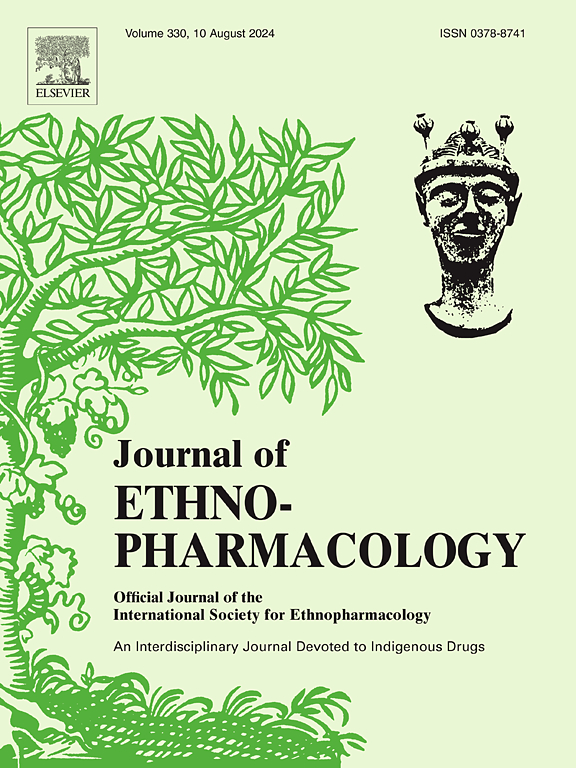Piper kadsura (Choisy) Ohwi: A comprehensive review of botany, traditional uses, phytochemistry, pharmacology, and quality control
IF 4.8
2区 医学
Q1 CHEMISTRY, MEDICINAL
引用次数: 0
Abstract
Ethnopharmacological relevance
Piper kadsura (Choisy) Ohwi (P. kadsura), locally known as “Haifengteng”, is a traditional East Asian herb with over 2000 years of ethnomedicinal use. It exhibits traditional therapeutic effects, including dispelling rheumatism, dredging meridians, and alleviating arthralgia, and is primarily used to prevent and treat rheumatic diseases.
Aim of the study
This paper reviews the research progress on the botany, traditional uses, phytochemistry, pharmacology, and quality control of P. kadsura to provide a scientific basis for its rational utilization and further research.
Materials and methods
The information on P. kadsura was obtained from books related to traditional Chinese medicine and electronic databases, including Web of Science, PubMed, Google Scholar, and CNKI.
Results
P. kadsura has shown significant efficacy in preventing and treating rheumatic diseases when used alone, in herbal formulations, or in traditional Chinese medicated diets. To date, 208 compounds, including phenylpropanoids, alkaloids, terpenoids, steroids, flavonoids, and others, as well as 379 essential oils, have been identified in P. kadsura. Pharmacological studies have confirmed that its extracts and compounds exhibit diverse activities, including anti-platelet activating factor, anti-inflammatory, analgesic, antioxidant, neuroprotective effects against Alzheimer's disease, anticancer, antiviral, and harmful biological control effects.
Conclusions
P. kadsura exhibits a diverse chemical composition and a wide range of pharmacological activities. Despite recent research progress, there are still some deficiencies, including limited isolation studies of new compounds, incomplete elucidation of some pharmacological mechanisms, significant gaps in pharmacokinetic research, and the need for standardized quality control measures. Future research should address these issues to fully realize its medicinal potential and value.

Piper kadsura (Choisy) Ohwi:植物学,传统用途,植物化学,药理学和质量控制的综合综述。
民族药理学相关性:风笛(音)(P. kadsura),当地称为“海凤藤”,是一种具有2000多年民族医学使用历史的东亚传统草药。它具有传统的治疗作用,包括祛湿,疏通经络,缓解关节痛,主要用于预防和治疗风湿病。摘要目的:综述了其在植物学、传统用途、植物化学、药理和质量控制等方面的研究进展,为其合理利用和进一步研究提供科学依据。材料与方法:利用Web of Science、PubMed、谷歌Scholar、中国知网等中医药相关文献和电子数据库,获取了香菇草的相关信息。结果:当单独使用时,在草药配方中,或在传统中药饮食中,牛角草已显示出显著的预防和治疗风湿病的功效。迄今为止,已鉴定出苯丙素、生物碱、萜类、类固醇、类黄酮等208种化合物和379种精油。药理学研究证实其提取物和化合物具有多种活性,包括抗血小板活化因子、抗炎、镇痛、抗氧化、抗阿尔茨海默病神经保护、抗癌、抗病毒和有害生物防治作用。结论:苦参具有丰富的化学成分和广泛的药理活性。尽管最近的研究取得了进展,但仍存在一些不足,包括新化合物的分离研究有限,一些药理机制的阐明不完整,药代动力学研究存在重大空白,需要标准化的质量控制措施。未来的研究应解决这些问题,充分发挥其药用潜力和价值。
本文章由计算机程序翻译,如有差异,请以英文原文为准。
求助全文
约1分钟内获得全文
求助全文
来源期刊

Journal of ethnopharmacology
医学-全科医学与补充医学
CiteScore
10.30
自引率
5.60%
发文量
967
审稿时长
77 days
期刊介绍:
The Journal of Ethnopharmacology is dedicated to the exchange of information and understandings about people''s use of plants, fungi, animals, microorganisms and minerals and their biological and pharmacological effects based on the principles established through international conventions. Early people confronted with illness and disease, discovered a wealth of useful therapeutic agents in the plant and animal kingdoms. The empirical knowledge of these medicinal substances and their toxic potential was passed on by oral tradition and sometimes recorded in herbals and other texts on materia medica. Many valuable drugs of today (e.g., atropine, ephedrine, tubocurarine, digoxin, reserpine) came into use through the study of indigenous remedies. Chemists continue to use plant-derived drugs (e.g., morphine, taxol, physostigmine, quinidine, emetine) as prototypes in their attempts to develop more effective and less toxic medicinals.
 求助内容:
求助内容: 应助结果提醒方式:
应助结果提醒方式:


